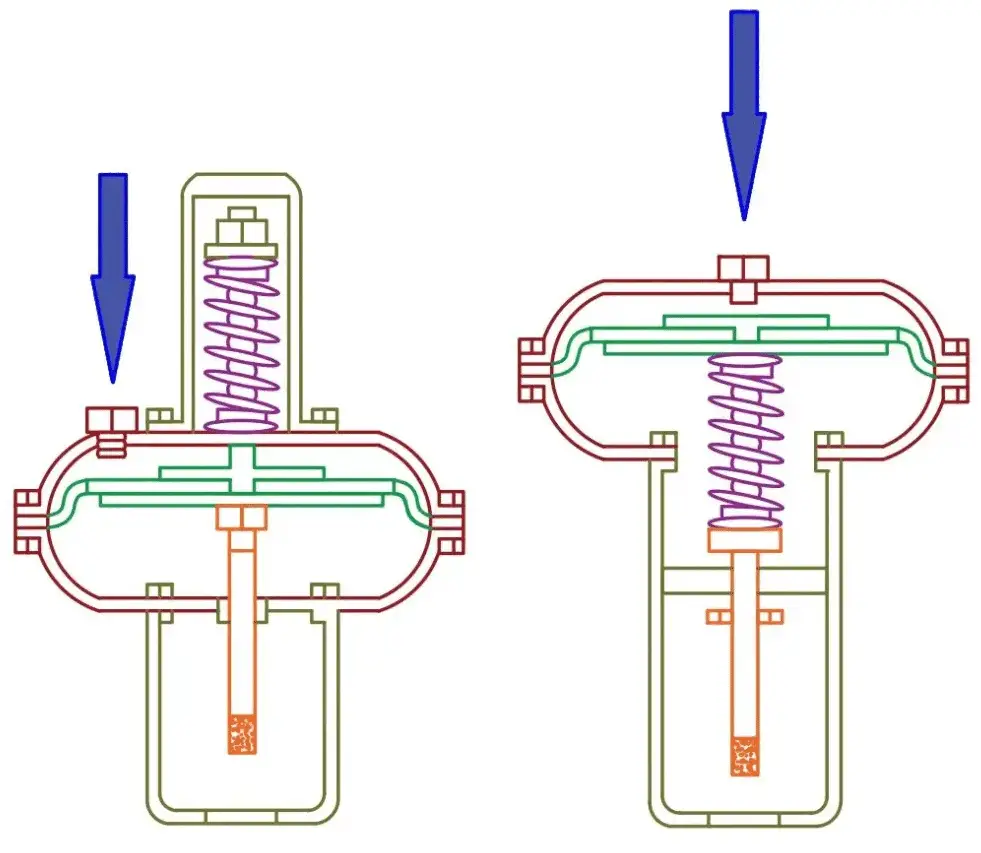In this article, we will discuss Direct Acting Control Valves & Reverse Acting Control Valves. Actuators are categorized as direct acting and reverse acting.
Actuators
Valve actuators are the devices that are used for positioning a valve. They are able to fully open, fully close, or provide precise control like regulation of flow to a tank, etc. the actuators can be classified as direct-acting or reverse-acting actuators.
When a reverse-acting actuator will observe an increase in the pneumatic pressure that is applied to the diaphragm, the valve stem will be lifted up. In such a case, the valve is normally seated and opens when air is supplied. Valves with such an actuator are called air-to-open valves (ATO) or fail-close (FC).
When a direct-acting actuator observes an increase in the pneumatic pressure which is applied to the diaphragm, the valve stem extends thus closing the valve. In such a case, the valve is normally open and closes when air is supplied. Valves with such an actuator are called air-to-close valves (ATC) or fail-open (FO).
The selection of the valve action is based on safety considerations and process guidelines.
Direct Acting Valves
The direct-acting valves are also known as air-to-close (ATC) or fail-open (FO) valves. This means that they are in an open position in case of failure of air supply.
In the case of the sliding stem valves, a direct-acting actuator will push down the stem by increasing the pressure. In the sliding stem valves, the body of the valve is classified as direct-acting if they open when the stem is lifted. The direct-acting valve is shown in the below figure.

As shown by an arrow in the figure, the instrument air is applied at a particular point. Due to the pressure of air, the diaphragm will change its shape. This will result in the change of position of the valve stem which is attached to the diaphragm.
Generally, in such valves, the air is supplied to the top side of the diaphragm as shown in the second valve of Figure 1. The spring is usually mounted on the bottom of the diaphragm. Thus, on supplying air, the actuator stem moves down thereby causing the valve to close. On the release of air, the valve would again move to the open position.
But in case the valve has a spring above the diaphragm in its construction, the air supply is provided above the diaphragm.
The direct-acting control loop has certain control loops, which depict the action of instruments like the controller, valve positioner, and control valve. They are:
Controller Action: When the value of process variables, for example, flow, temperature, pressure, etc increase, then the controller’s output signal will also increase in proportion to it and vice versa.
Valve Positioner Action: At this step when the output signal from the controller will be increased, the air pressure or output load from the positioner of the valve would also increase. It is also true and vice versa.
Control Valve Action: The valve plug will travel toward the closed position when the load or air pressure on the actuator of the valve increases because it is an air-to-close valve.
Reverse Acting Valves
The reverse-acting valves are also known as air-to-open (ATO) or fail-close (FC) valves. This means that they are in a closed position in case of failure of air supply.
In the case of the sliding stem valves, a reverse-acting actuator will pull up the stem by increasing the pressure. In the sliding stem valves, the body of the valve is classified as reverse-acting if it shut off when the stem is lifted. The reverse-acting valve is shown in the below figure.

Generally, in such valves, the air is supplied to the bottom side of the diaphragm as shown in the first valve of Figure 2. The spring is generally mounted on the top of the diaphragm. Thus, on supplying air, the actuator stem moves up thereby causing the valve to open. On the release of air, the valve would again move to the close position.
But in case the valve has a spring below the diaphragm in its construction, the air supply is provided below the diaphragm.
The reverse-acting control loop has certain control loops, which depict the action of instruments like the controller, valve positioner, and control valve. They are:
Controller Action: When the value of process variables, for example, flow, temperature, pressure, etc increases, then the controller’s output signal will decrease in proportion to it and vice versa.
Valve Positioner Action: In this, when the output signal from the controller will be increased, the air pressure or output load from the positioner of the valve would also decrease. It is also true and vice versa.
Control Valve Action: The valve plug will travel toward the open position when the load or air pressure on the actuator of the valve increases because it is an air-to-open valve.